Individual Essay: Critical Analysis of Hofstede's Culture
VerifiedAdded on 2020/10/22
|6
|1357
|196
Essay
AI Summary
This essay provides a critical analysis of Geert Hofstede's cultural dimensions and their influence on organizational behavior. It begins with an introduction to organizational culture and its components, then delves into the four key dimensions: individualism/collectivism, power distance, uncertainty avoidance, and masculinity/femininity. The essay evaluates the suggestions made in the article regarding the use of Hofstede's culture, providing both agreeable and disagreeable opinions. It further explores the implications of these dimensions on global business practices, particularly for companies operating internationally. The essay also offers suggestions for fostering a positive work culture, emphasizing the importance of strategic direction, teamwork, and a flexible organizational structure. The conclusion summarizes the impact of culture on the organization and provides insights on the application of Hofstede's cultural dimensions, along with recommendations for businesses.
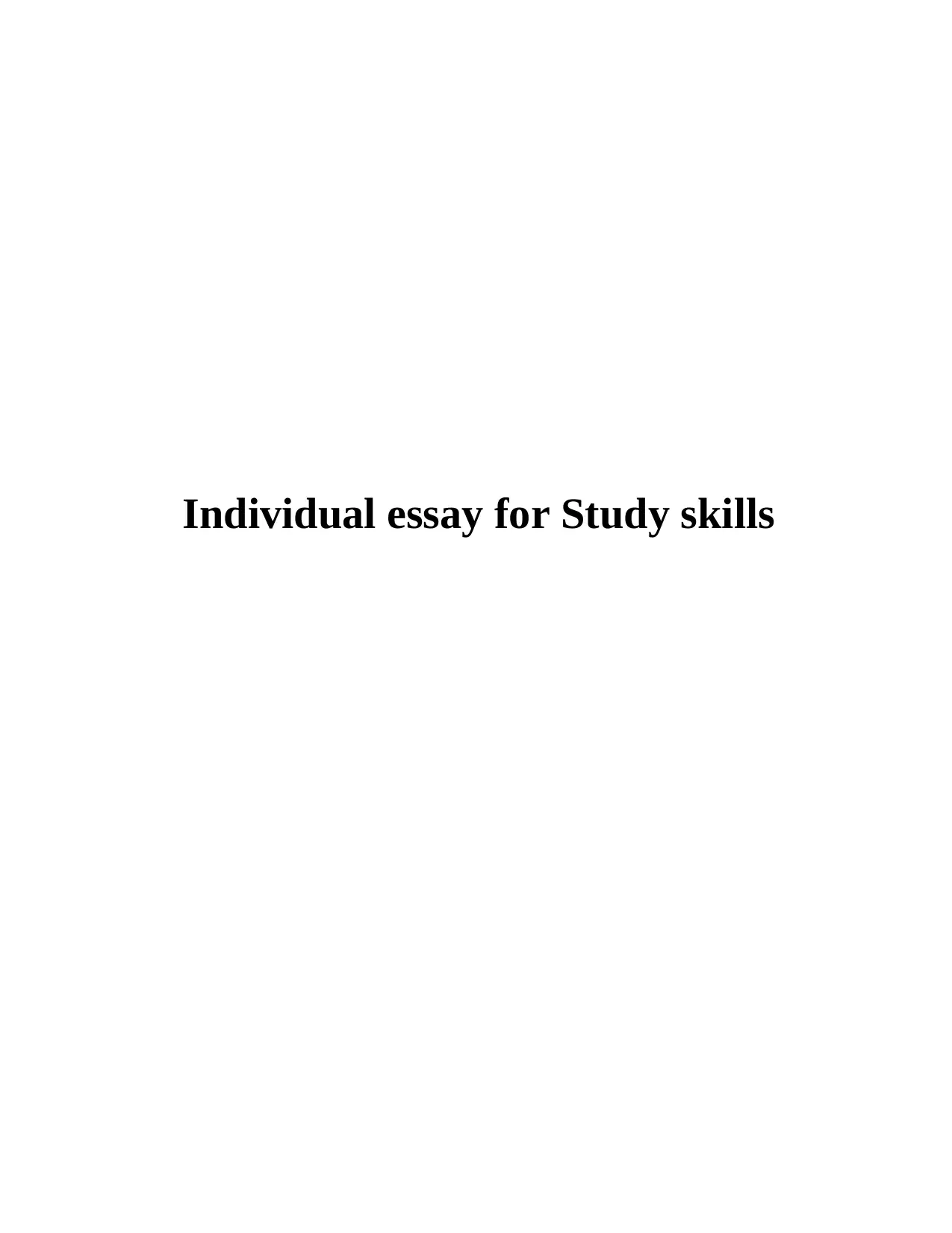
Individual essay for Study skills
Paraphrase This Document
Need a fresh take? Get an instant paraphrase of this document with our AI Paraphraser
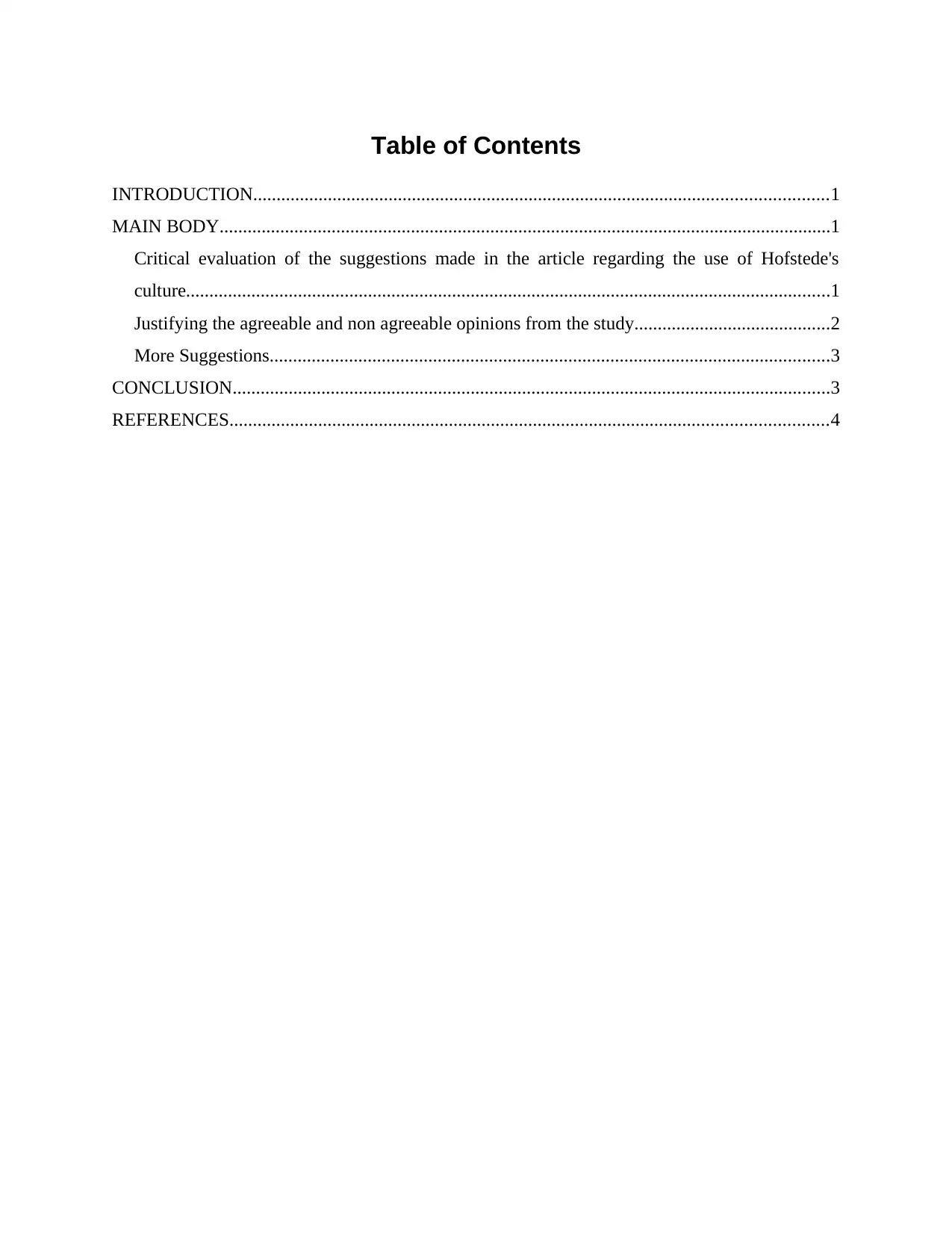
Table of Contents
INTRODUCTION...........................................................................................................................1
MAIN BODY...................................................................................................................................1
Critical evaluation of the suggestions made in the article regarding the use of Hofstede's
culture..........................................................................................................................................1
Justifying the agreeable and non agreeable opinions from the study..........................................2
More Suggestions........................................................................................................................3
CONCLUSION................................................................................................................................3
REFERENCES................................................................................................................................4
INTRODUCTION...........................................................................................................................1
MAIN BODY...................................................................................................................................1
Critical evaluation of the suggestions made in the article regarding the use of Hofstede's
culture..........................................................................................................................................1
Justifying the agreeable and non agreeable opinions from the study..........................................2
More Suggestions........................................................................................................................3
CONCLUSION................................................................................................................................3
REFERENCES................................................................................................................................4
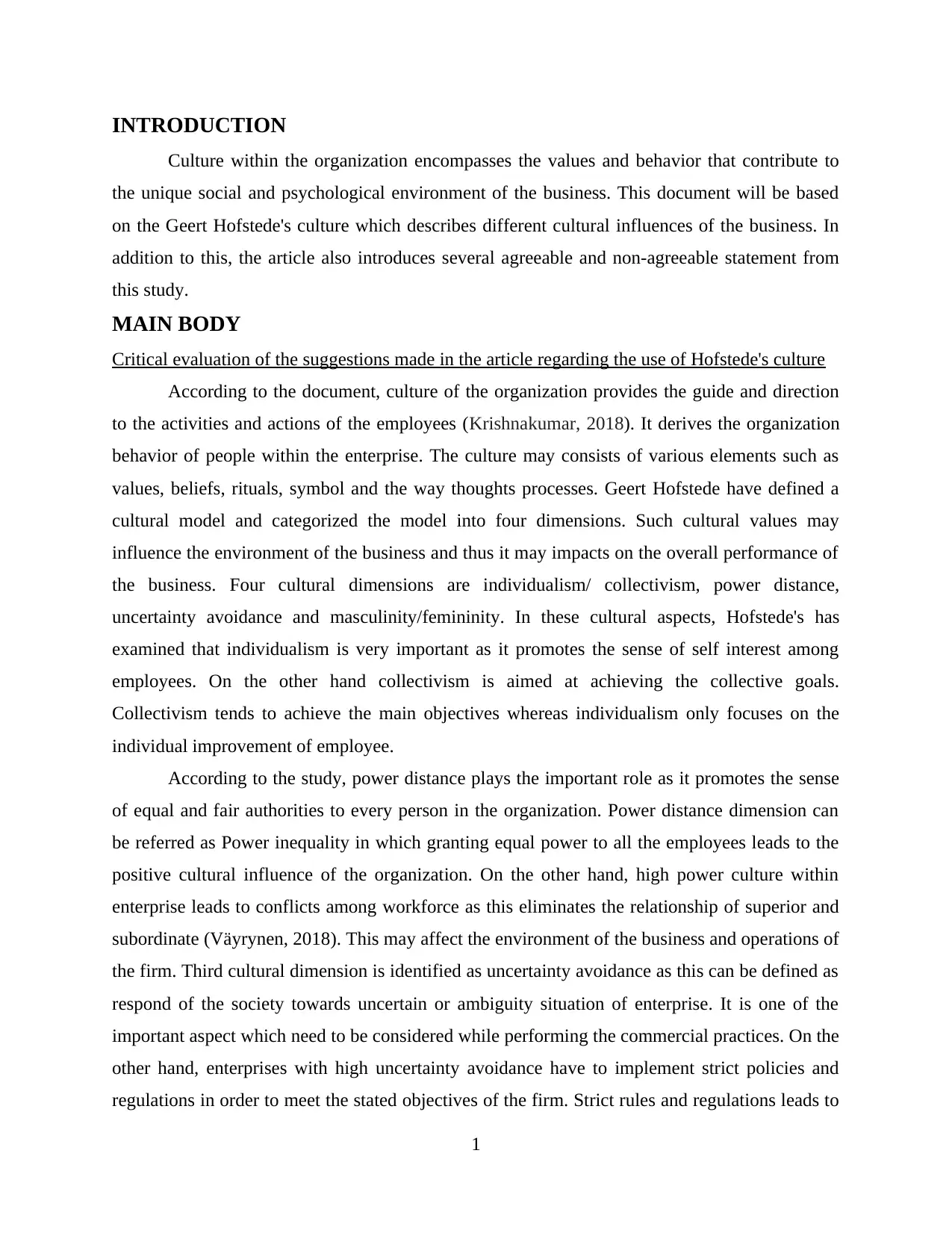
INTRODUCTION
Culture within the organization encompasses the values and behavior that contribute to
the unique social and psychological environment of the business. This document will be based
on the Geert Hofstede's culture which describes different cultural influences of the business. In
addition to this, the article also introduces several agreeable and non-agreeable statement from
this study.
MAIN BODY
Critical evaluation of the suggestions made in the article regarding the use of Hofstede's culture
According to the document, culture of the organization provides the guide and direction
to the activities and actions of the employees (Krishnakumar, 2018). It derives the organization
behavior of people within the enterprise. The culture may consists of various elements such as
values, beliefs, rituals, symbol and the way thoughts processes. Geert Hofstede have defined a
cultural model and categorized the model into four dimensions. Such cultural values may
influence the environment of the business and thus it may impacts on the overall performance of
the business. Four cultural dimensions are individualism/ collectivism, power distance,
uncertainty avoidance and masculinity/femininity. In these cultural aspects, Hofstede's has
examined that individualism is very important as it promotes the sense of self interest among
employees. On the other hand collectivism is aimed at achieving the collective goals.
Collectivism tends to achieve the main objectives whereas individualism only focuses on the
individual improvement of employee.
According to the study, power distance plays the important role as it promotes the sense
of equal and fair authorities to every person in the organization. Power distance dimension can
be referred as Power inequality in which granting equal power to all the employees leads to the
positive cultural influence of the organization. On the other hand, high power culture within
enterprise leads to conflicts among workforce as this eliminates the relationship of superior and
subordinate (Väyrynen, 2018). This may affect the environment of the business and operations of
the firm. Third cultural dimension is identified as uncertainty avoidance as this can be defined as
respond of the society towards uncertain or ambiguity situation of enterprise. It is one of the
important aspect which need to be considered while performing the commercial practices. On the
other hand, enterprises with high uncertainty avoidance have to implement strict policies and
regulations in order to meet the stated objectives of the firm. Strict rules and regulations leads to
1
Culture within the organization encompasses the values and behavior that contribute to
the unique social and psychological environment of the business. This document will be based
on the Geert Hofstede's culture which describes different cultural influences of the business. In
addition to this, the article also introduces several agreeable and non-agreeable statement from
this study.
MAIN BODY
Critical evaluation of the suggestions made in the article regarding the use of Hofstede's culture
According to the document, culture of the organization provides the guide and direction
to the activities and actions of the employees (Krishnakumar, 2018). It derives the organization
behavior of people within the enterprise. The culture may consists of various elements such as
values, beliefs, rituals, symbol and the way thoughts processes. Geert Hofstede have defined a
cultural model and categorized the model into four dimensions. Such cultural values may
influence the environment of the business and thus it may impacts on the overall performance of
the business. Four cultural dimensions are individualism/ collectivism, power distance,
uncertainty avoidance and masculinity/femininity. In these cultural aspects, Hofstede's has
examined that individualism is very important as it promotes the sense of self interest among
employees. On the other hand collectivism is aimed at achieving the collective goals.
Collectivism tends to achieve the main objectives whereas individualism only focuses on the
individual improvement of employee.
According to the study, power distance plays the important role as it promotes the sense
of equal and fair authorities to every person in the organization. Power distance dimension can
be referred as Power inequality in which granting equal power to all the employees leads to the
positive cultural influence of the organization. On the other hand, high power culture within
enterprise leads to conflicts among workforce as this eliminates the relationship of superior and
subordinate (Väyrynen, 2018). This may affect the environment of the business and operations of
the firm. Third cultural dimension is identified as uncertainty avoidance as this can be defined as
respond of the society towards uncertain or ambiguity situation of enterprise. It is one of the
important aspect which need to be considered while performing the commercial practices. On the
other hand, enterprises with high uncertainty avoidance have to implement strict policies and
regulations in order to meet the stated objectives of the firm. Strict rules and regulations leads to
1
⊘ This is a preview!⊘
Do you want full access?
Subscribe today to unlock all pages.

Trusted by 1+ million students worldwide
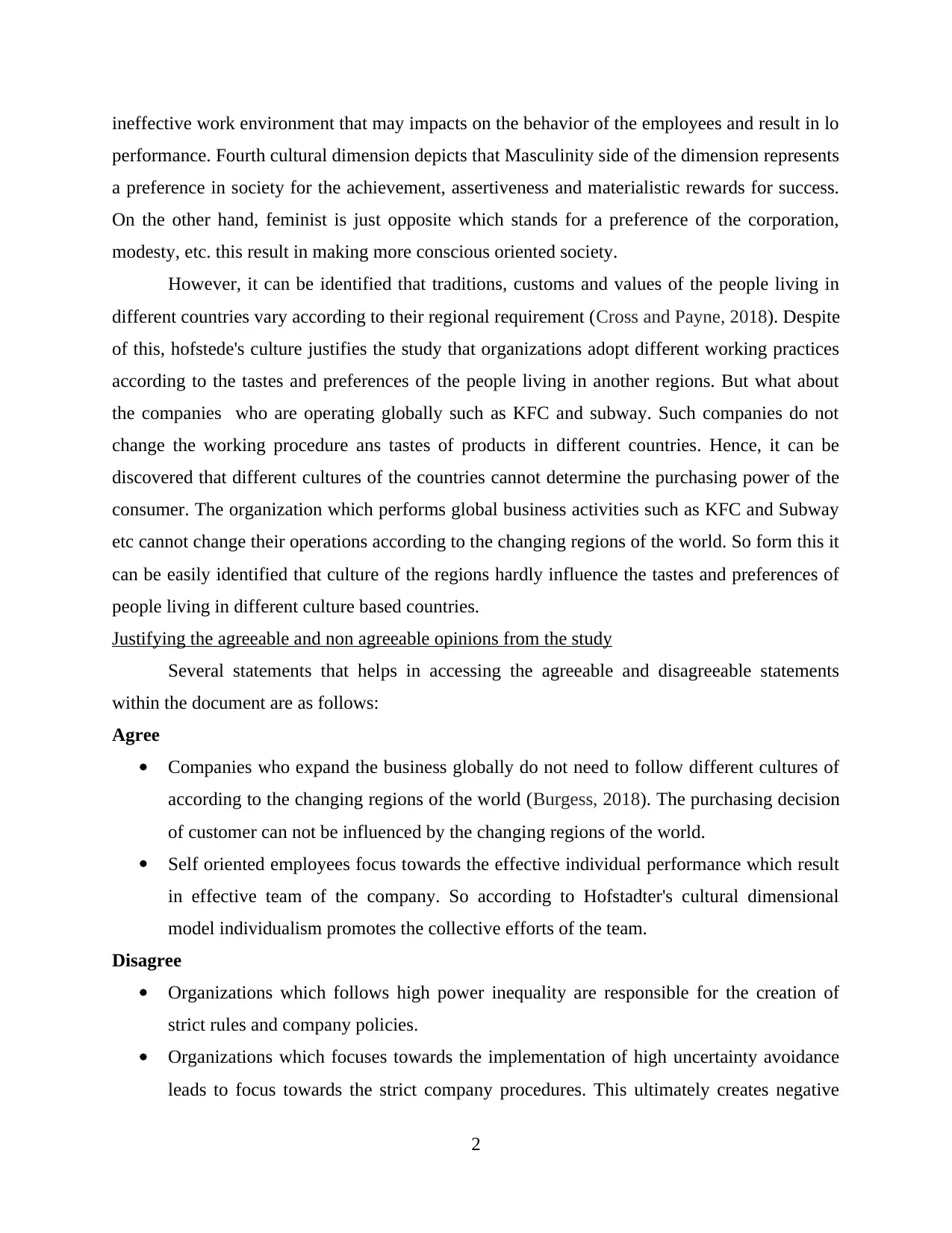
ineffective work environment that may impacts on the behavior of the employees and result in lo
performance. Fourth cultural dimension depicts that Masculinity side of the dimension represents
a preference in society for the achievement, assertiveness and materialistic rewards for success.
On the other hand, feminist is just opposite which stands for a preference of the corporation,
modesty, etc. this result in making more conscious oriented society.
However, it can be identified that traditions, customs and values of the people living in
different countries vary according to their regional requirement (Cross and Payne, 2018). Despite
of this, hofstede's culture justifies the study that organizations adopt different working practices
according to the tastes and preferences of the people living in another regions. But what about
the companies who are operating globally such as KFC and subway. Such companies do not
change the working procedure ans tastes of products in different countries. Hence, it can be
discovered that different cultures of the countries cannot determine the purchasing power of the
consumer. The organization which performs global business activities such as KFC and Subway
etc cannot change their operations according to the changing regions of the world. So form this it
can be easily identified that culture of the regions hardly influence the tastes and preferences of
people living in different culture based countries.
Justifying the agreeable and non agreeable opinions from the study
Several statements that helps in accessing the agreeable and disagreeable statements
within the document are as follows:
Agree
Companies who expand the business globally do not need to follow different cultures of
according to the changing regions of the world (Burgess, 2018). The purchasing decision
of customer can not be influenced by the changing regions of the world.
Self oriented employees focus towards the effective individual performance which result
in effective team of the company. So according to Hofstadter's cultural dimensional
model individualism promotes the collective efforts of the team.
Disagree
Organizations which follows high power inequality are responsible for the creation of
strict rules and company policies.
Organizations which focuses towards the implementation of high uncertainty avoidance
leads to focus towards the strict company procedures. This ultimately creates negative
2
performance. Fourth cultural dimension depicts that Masculinity side of the dimension represents
a preference in society for the achievement, assertiveness and materialistic rewards for success.
On the other hand, feminist is just opposite which stands for a preference of the corporation,
modesty, etc. this result in making more conscious oriented society.
However, it can be identified that traditions, customs and values of the people living in
different countries vary according to their regional requirement (Cross and Payne, 2018). Despite
of this, hofstede's culture justifies the study that organizations adopt different working practices
according to the tastes and preferences of the people living in another regions. But what about
the companies who are operating globally such as KFC and subway. Such companies do not
change the working procedure ans tastes of products in different countries. Hence, it can be
discovered that different cultures of the countries cannot determine the purchasing power of the
consumer. The organization which performs global business activities such as KFC and Subway
etc cannot change their operations according to the changing regions of the world. So form this it
can be easily identified that culture of the regions hardly influence the tastes and preferences of
people living in different culture based countries.
Justifying the agreeable and non agreeable opinions from the study
Several statements that helps in accessing the agreeable and disagreeable statements
within the document are as follows:
Agree
Companies who expand the business globally do not need to follow different cultures of
according to the changing regions of the world (Burgess, 2018). The purchasing decision
of customer can not be influenced by the changing regions of the world.
Self oriented employees focus towards the effective individual performance which result
in effective team of the company. So according to Hofstadter's cultural dimensional
model individualism promotes the collective efforts of the team.
Disagree
Organizations which follows high power inequality are responsible for the creation of
strict rules and company policies.
Organizations which focuses towards the implementation of high uncertainty avoidance
leads to focus towards the strict company procedures. This ultimately creates negative
2
Paraphrase This Document
Need a fresh take? Get an instant paraphrase of this document with our AI Paraphraser
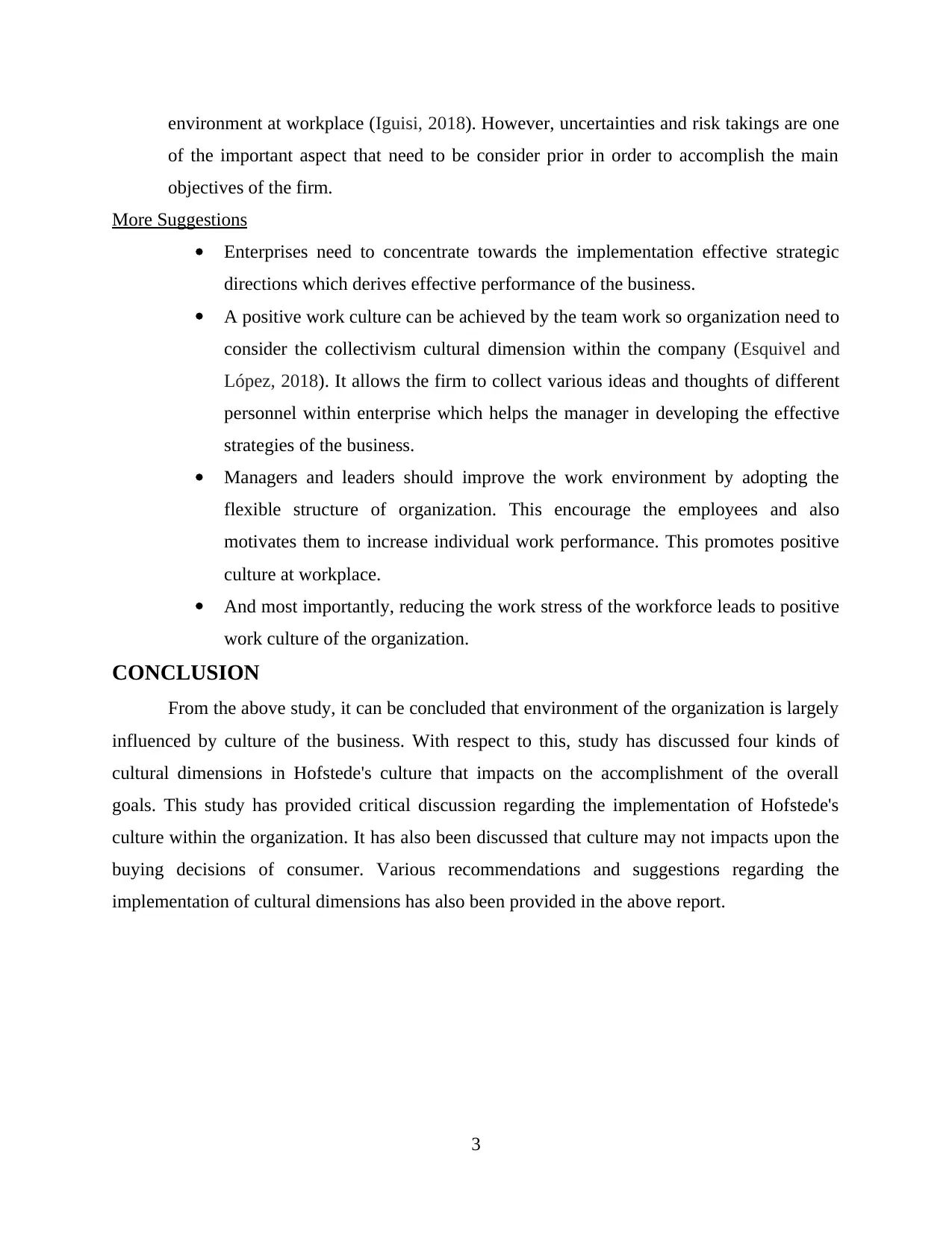
environment at workplace (Iguisi, 2018). However, uncertainties and risk takings are one
of the important aspect that need to be consider prior in order to accomplish the main
objectives of the firm.
More Suggestions
Enterprises need to concentrate towards the implementation effective strategic
directions which derives effective performance of the business.
A positive work culture can be achieved by the team work so organization need to
consider the collectivism cultural dimension within the company (Esquivel and
López, 2018). It allows the firm to collect various ideas and thoughts of different
personnel within enterprise which helps the manager in developing the effective
strategies of the business.
Managers and leaders should improve the work environment by adopting the
flexible structure of organization. This encourage the employees and also
motivates them to increase individual work performance. This promotes positive
culture at workplace.
And most importantly, reducing the work stress of the workforce leads to positive
work culture of the organization.
CONCLUSION
From the above study, it can be concluded that environment of the organization is largely
influenced by culture of the business. With respect to this, study has discussed four kinds of
cultural dimensions in Hofstede's culture that impacts on the accomplishment of the overall
goals. This study has provided critical discussion regarding the implementation of Hofstede's
culture within the organization. It has also been discussed that culture may not impacts upon the
buying decisions of consumer. Various recommendations and suggestions regarding the
implementation of cultural dimensions has also been provided in the above report.
3
of the important aspect that need to be consider prior in order to accomplish the main
objectives of the firm.
More Suggestions
Enterprises need to concentrate towards the implementation effective strategic
directions which derives effective performance of the business.
A positive work culture can be achieved by the team work so organization need to
consider the collectivism cultural dimension within the company (Esquivel and
López, 2018). It allows the firm to collect various ideas and thoughts of different
personnel within enterprise which helps the manager in developing the effective
strategies of the business.
Managers and leaders should improve the work environment by adopting the
flexible structure of organization. This encourage the employees and also
motivates them to increase individual work performance. This promotes positive
culture at workplace.
And most importantly, reducing the work stress of the workforce leads to positive
work culture of the organization.
CONCLUSION
From the above study, it can be concluded that environment of the organization is largely
influenced by culture of the business. With respect to this, study has discussed four kinds of
cultural dimensions in Hofstede's culture that impacts on the accomplishment of the overall
goals. This study has provided critical discussion regarding the implementation of Hofstede's
culture within the organization. It has also been discussed that culture may not impacts upon the
buying decisions of consumer. Various recommendations and suggestions regarding the
implementation of cultural dimensions has also been provided in the above report.
3
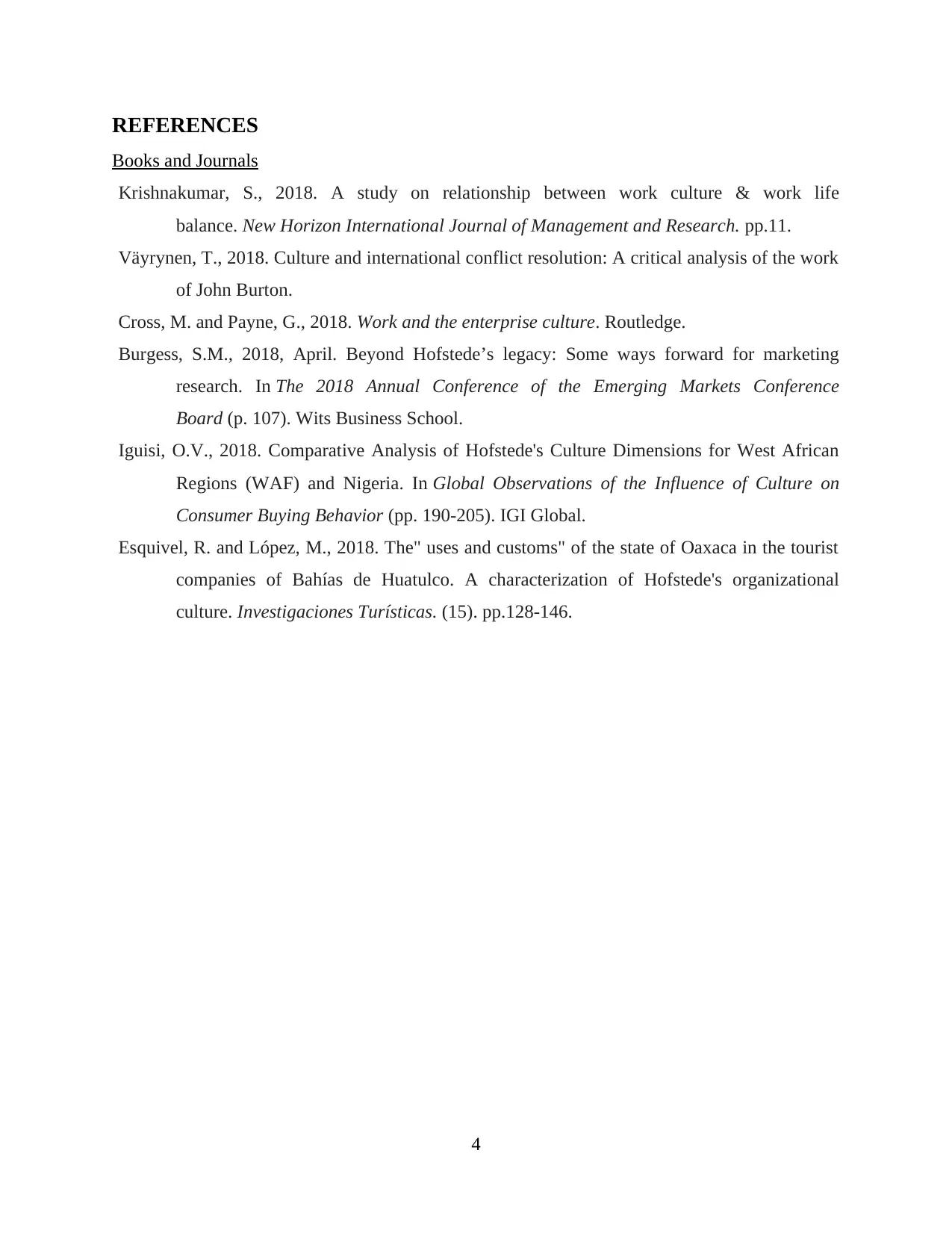
REFERENCES
Books and Journals
Krishnakumar, S., 2018. A study on relationship between work culture & work life
balance. New Horizon International Journal of Management and Research. pp.11.
Väyrynen, T., 2018. Culture and international conflict resolution: A critical analysis of the work
of John Burton.
Cross, M. and Payne, G., 2018. Work and the enterprise culture. Routledge.
Burgess, S.M., 2018, April. Beyond Hofstede’s legacy: Some ways forward for marketing
research. In The 2018 Annual Conference of the Emerging Markets Conference
Board (p. 107). Wits Business School.
Iguisi, O.V., 2018. Comparative Analysis of Hofstede's Culture Dimensions for West African
Regions (WAF) and Nigeria. In Global Observations of the Influence of Culture on
Consumer Buying Behavior (pp. 190-205). IGI Global.
Esquivel, R. and López, M., 2018. The" uses and customs" of the state of Oaxaca in the tourist
companies of Bahías de Huatulco. A characterization of Hofstede's organizational
culture. Investigaciones Turísticas. (15). pp.128-146.
4
Books and Journals
Krishnakumar, S., 2018. A study on relationship between work culture & work life
balance. New Horizon International Journal of Management and Research. pp.11.
Väyrynen, T., 2018. Culture and international conflict resolution: A critical analysis of the work
of John Burton.
Cross, M. and Payne, G., 2018. Work and the enterprise culture. Routledge.
Burgess, S.M., 2018, April. Beyond Hofstede’s legacy: Some ways forward for marketing
research. In The 2018 Annual Conference of the Emerging Markets Conference
Board (p. 107). Wits Business School.
Iguisi, O.V., 2018. Comparative Analysis of Hofstede's Culture Dimensions for West African
Regions (WAF) and Nigeria. In Global Observations of the Influence of Culture on
Consumer Buying Behavior (pp. 190-205). IGI Global.
Esquivel, R. and López, M., 2018. The" uses and customs" of the state of Oaxaca in the tourist
companies of Bahías de Huatulco. A characterization of Hofstede's organizational
culture. Investigaciones Turísticas. (15). pp.128-146.
4
⊘ This is a preview!⊘
Do you want full access?
Subscribe today to unlock all pages.

Trusted by 1+ million students worldwide
1 out of 6
Related Documents
Your All-in-One AI-Powered Toolkit for Academic Success.
+13062052269
info@desklib.com
Available 24*7 on WhatsApp / Email
![[object Object]](/_next/static/media/star-bottom.7253800d.svg)
Unlock your academic potential
Copyright © 2020–2025 A2Z Services. All Rights Reserved. Developed and managed by ZUCOL.





